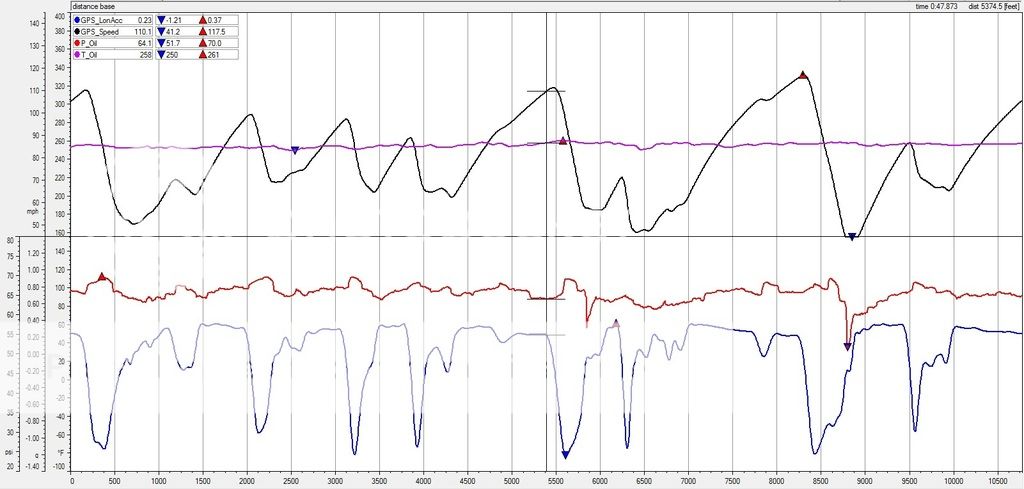I experimented a little with overfilling the Moroso oil pan at Gingerman Raceway this past weekend, so I thought I would resurrect this thread again to share my findings.
I had previously filled the pan to ~11 qt, and I added another 1/2 qt before starting the weekend. I'm not sure how much oil I've burned since originally filling the pan, but I doubt it's much.
Here is a comparison of oil pressure (in red) with vehicle speed (in black), lateral acceleration (in green), and longitudinal acceleration (in blue):
Just like at Mid-Ohio, the majority of the pressure loss occurred in longer braking zones. However, now I'm seeing a drop in the middle of a corner (turn 6). I don't quite understand why because there is no pressure loss in 7-8-9, and lateral acceleration is just at high there (both left and right). I don't know the specs of the oil pressure relief valve in the oil pump, but it's possible that the lower engine speed causes weird things to happen when the hot, aerated oil goes through the pump.
After sorting through data, it definitely looks like there is a correlation with oil temperature (on the top half of the following graph):
In general, oil pressure loss occurs in long braking zones regardless of oil temperature. However, the hotter the oil gets, the more pressure loss occurs in turn 6.
The next day, I put in another 1/2 quart to see what happens. Here is the result:
Overall, there was a large improvement in pressure except in the braking zones going into turn 10 (which is downhill) and into turn 12 (which is 400' long). There was no pressure loss in turn 6 until the oil temperature was ~280 degF. As ArizonaGT suggested, the system is very sensitive to oil volume, and despite the 10 quart capacity specified by Moroso, you have to overfill the pan.
Since I mostly just run time trial events, I don't really want to drop hundreds of dollars on an oil cooler when I only need to put down 1-2 laps per session. I'll continue to add oil in 1/2 quart increments to find a safe range that will reduce starvation but still not let the oil level get so high that it hits the crankshaft when it sloshes.
Something else I noticed at this event was that I had to drain my catch cans after every session. If I stayed out for the whole 15 minutes, I would drain close to 1 cup of oil out of both my breather and PCV catch cans, and previously it was only a few tablespoons. I don't know if this is caused by the higher oil level or from excessive blow-by. Hopefully I didn't break something...













